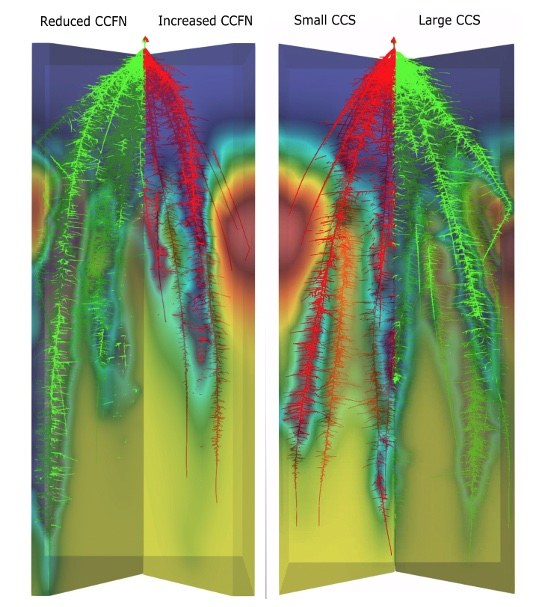
Visualized output of the simulated root architecture of reduced CCFN (right panel, green), increased CCFN (right panel red), small CCS (left panel, red) and small CCS (left panel, green) under moderated N stress. The continuous gradient from red to blue in the simulated soil represents the nitrogen depletion by the root uptake and leaching.
Authors
Ivan Lopez-Valdivia, Xiyu Yang, Jonathan P. Lynch
Source
Plant Physiology 2023 192(3): 2261–2275
Download Options
Abstract
We used OpenSimRoot, a functional-structural plant/soil model, to test the hypothesis that larger root cortical cell size (CCS), and reduced cortical cell file number (CCFN), and their interactions with root cortical aerenchyma (RCA) and lateral root branching density (LRBD), are useful adaptations to suboptimal soil nitrogen availability. Reduced CCFN increased shoot dry weight over 80%. Reduced respiration, reduced nitrogen content, and reduced root diameter accounted for 23%, 20%, and 33% of increased shoot biomass, respectively. Large CCS increased shoot biomass by 24% compared with small CCS. When simulated independently, reduced respiration and reduced nutrient content increased the shoot biomass by 14% and 3%, respectively. However, increased root diameter resulting from large CCS decreased shoot biomass by 4% due to an increase in root metabolic cost. Under moderate N stress, integrated phenotypes with reduced CCFN, large CCS, and high RCA improved shoot biomass in silt loam and loamy sand soils. In contrast, integrated phenotypes composed of reduced CCFN, large CCS and reduced lateral root branching density had the greatest growth in silt loam, while phenotypes with reduced CCFN, large CCS and high LRBD were the best performers in loamy sands. Our results support the hypothesis that larger CCS, reduced CCFN, and their interactions with RCA and LRBD could increase nitrogen acquisition by reducing root respiration and root nutrient demand. Phene synergisms may exist between CCS, CCFN, and LRBD. CCS and CCFN merit consideration for breeding cereal crops with improved nitrogen acquisition, which is critical for global food security.

